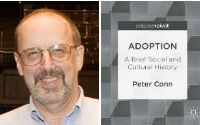Penn Professor Explores History of Adoption in New Book
The question caused consternation.
Several decades ago when Peter Conn and his wife filled out paperwork to adopt a baby girl from Korea, one of the questions on a state government form was about the number and names of their “natural” children.
“We thought about sending the Commonwealth a letter patiently explaining that, if our three biological children were natural, it meant that Jennifer was unnatural,” he recalls.
Conn, professor emeritus of English and education at the University of Pennsylvania, has an interest in adoption that is both personal and professional. He and his wife adopted their daughter through Welcome House, an international adoption agency founded by Pearl S. Buck in 1949. Conn served as chairman of the board of the Pearl Buck Foundation.
His most recent book, Adoption: A Brief Social and Cultural History, is a resource for understanding the issues faced by some 6 million adoptees in the United States as well as millions of other adopted children around the world. It weaves together philosophy, history, anthropology, literary criticism, law and related fields.
Conn will discuss the book and sign copies of it beginning at 5:30 p.m., April 3, at the Penn Bookstore located at 3601 Walnut St.
Adoption breaks new ground in the literature. When Conn began his research for the book, he says he thought he’d begin by reading all the existing histories of adoption.
“There were thousands of memoirs by adoptees and their families, technical and social work books on the rules and regulations and laws of adoption and scholarly micro studies, for example ‘Adoption in Greece in the Fourth Century BCE.’”
Conn was surprised, however, to find that there were no books on adoption history.
Conn‘s book is a global history of adoption from the oldest recorded adoption 4,000 years ago. He writes that in 1851 the United States enacted the world’s first law establishing the adoption of a minor child into a family, setting in motion an enormous transformation in modern cultures about the best interest of the child.
“For me it was a shock that the best interest of the child philosophy is relatively new. Adoption had to do with continuity of family, property and name,” Conn says.
Typically adoption involved the introduction of an adult into a family for purposes of ensuring succession. The focus was on replacing or in some cases, providing for childless couples, a male heir for the male property holder.
Conn’s book also advances understanding of open adoption, interracial adoption, adoption by gay couples and international adoption.
“My wife and I and our children have been in this adoptive family for decades,” he says. “Part of the reason I wrote the book is to defend adoption as a way to build a family.”







